FastTrack Training. "Network Basics". Understanding Cisco Architecture. Eddie Martin December 2012
About a year ago, I noticed an interesting and fascinating series of lectures by Eddie Martin, which, thanks to its history and real-life examples, as well as its tremendous learning experience, is amazingly comprehensible and allows you to gain an understanding of quite complex technologies.

We continue the cycle of 27 articles based on his lectures:
')
01/02: “Understanding the OSI Model” Part 1 / Part 2
03: "Understanding the Cisco Architecture"
04/05: “The Basics of Switching or Switches” Part 1 / Part 2
06: "Switches from Cisco"
07: "Area of use of network switches, the value of Cisco switches"
08/09: "Basics of a Wireless LAN" Part 1 / Part 2
10: "Products in the field of wireless LAN"
11: The Value of Cisco Wireless LANs
12: Routing Basics
13: "The structure of routers, routing platforms from Cisco"
14: The Value of Cisco Routers
15/16: “The Basics of Data Centers” Part 1 / Part 2
17: "Equipment for data centers"
18: "The Value of Cisco in Data Centers"
19/20/21: "The Basics of Telephony" Part 1 / Part 2 / Part 3
22: "Cisco Collaboration Software"
23: The Value of Collaboration Products from Cisco
24: "The Basics of Security"
25: "Cisco Security Software"
26: "The Value of Cisco Security Products"
27: "Understanding Cisco Architectural Games (Review)"
And here is the third one.
We turn to the next section of our conversation - the architecture of Cisco. We will touch this question twice, at the beginning of our meetings and at the very end.
So what is architecture for and what does it mean for the client?
Architecture is a very important concept for Cisco. In which case the architecture becomes important to the client? It is important if it is effective. If it helps to interact with applications. But what do customers think when they hear the word architecture? They imagine a strategy or something like a roadmap. For them, the word architecture sounds expensive. We all heard about ABC clients. And what clients do we call ABC clients, or “first graders,” those who have not advanced further learning the alphabet? These are the clients that did not choose Cisco. And we have to lure them.
I am from North Carolina and we have a lot of basketball teams in our state, concentrated in a small region. I loved to joke that ABC is Anything But North Carolina, anyone, but not North Carolina. Because the University of North Carolina has the best basketball team, and Kentucky has the best, and so on. It also happens in the field of information technology - there is a significant layer of “entry level” clients who are not interested in complex issues.
Architecture becomes important if we are talking about long-term strategies. Do you think the IT industry is thinking about long-term prospects? Now I will show you something very clever that one sales person taught me. He said that every organization has a hierarchy. Downstairs are performers, including IT specialists, and I, too, was among them. These people do not look far into the future. They think: "God, it's Friday, it's almost a weekend!" Or: “It's Thursday, I jumped over the middle of the week”! They do not think about distant prospects. They work from project to project and live only today.
Then we move to the level of management, managers look a little further beyond the project and think about how its consequences will affect the company in a couple of months or six months. But they are not very strategically minded; it is important for them to control the timing, timely execution of projects. However, for the former, and for the latter, the architecture of the company does not matter much.
Above the managers are directors and other managers. These people have been looking at least a year in advance. They are more strategic and the architecture for them already has some meaning. In some firms, project architects are hired for special positions, and they should keep an eye on long-term prospects and consequences, since the majority do not care.
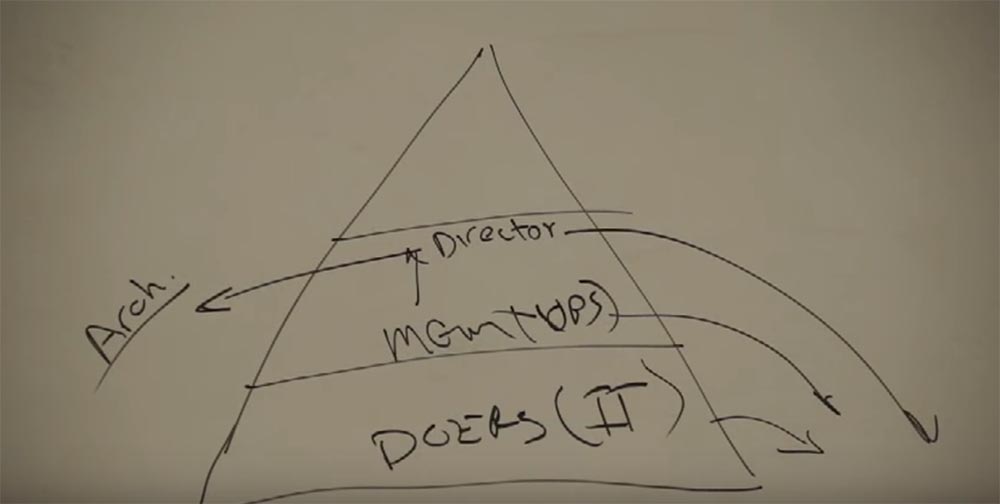
It is at this level that a specialist is located who performs the role of an architect in an organization and knows the names of managers and so on.
The highest level - VP, SVP, CXO, we consist of general managers, their heads and directors with extensive experience of interaction, that is, CXO. CXOs are people who are associated with the name of a company, they form a brand. And these people are looking at long-term prospects.

What do all these people think at the top? What words will we describe them? What do they want?
They all want money. Therefore, they care about everything that happens. If you have ideas, it’s better to go to the top level with them. If I say that I have a plan to improve the work of the sales department and they will believe me, such a person will even get a loan if he understands that the idea has a perspective. He will create a budget for you, these are great guys, really. He will think about improving the architecture, as he looks for several years ahead.
And now back to the base of the pyramid. All these people below do not think about the company's strategy or its architecture - they just work and sell the company's products. But they do it best of all, and it is thanks to their efforts that the upper parts of the pyramid exist.
So, if you do not have an architect, the whole structure is just a set of components. The architect binds her. At the lower level, people only think about mobility, about video, they use the words “switch” and “router”. But the people at the top of the pyramid do not care, they do very different things. These levels are unrelated. The architect must place all parts of the structure where it is needed, so that everything works as efficiently as possible.
Now let's talk about the architecture of information technology, the three main types of architecture, although Cisco has a couple of others. Let's start with the first type - unlimited network architecture. What it is? A limitless network is something new. This is a completely revolutionary solution for the IT-sphere.

Saying that this type scares IT specialists to death, I am not joking. What is included in the concept of unlimited architecture? Our routers, our switches, our wireless connection, our security tools, application acceleration and much more. This is the foundation required to build a building.

Once again I draw your attention to the fact that our basic products are the basis of this architecture, which is why we exist in the market. For the sake of sales, we launched IP telephony. Why did we start selling IP telephony? To sell more routers and switches. Because clients used hubs and they had routers. And they bought from us switches and routers, about which they thought they would use them for a long time and would not replace them in the next seven years.
The second type of architecture is the collaboration architecture, group architecture. Cisco started this in the distant 1997s. Then we did not call it group architecture, there was only an idea. It originates from IP telephony, which has led to unified cooperation in the field of communications. There were a total of three steps towards such cooperation. Again, we started this in the middle of the 1990s in the form of a vision, there were no ready-made products that could provide this. We had a lot of acquisitions back then, including Celsius, a lot of routing options, and this connected us with communication messengers, video solutions, everything that provides people with the ability to communicate with each other. Of all the types of architecture, I think this is the most important, as it gives us communication. I can be a little biased, and I will. Do your customers know which switches or routers you use in architecture and what changes are there? No, and this is a common joke. But we can change the way we communicate and thus change the way everyone does business in the organization.
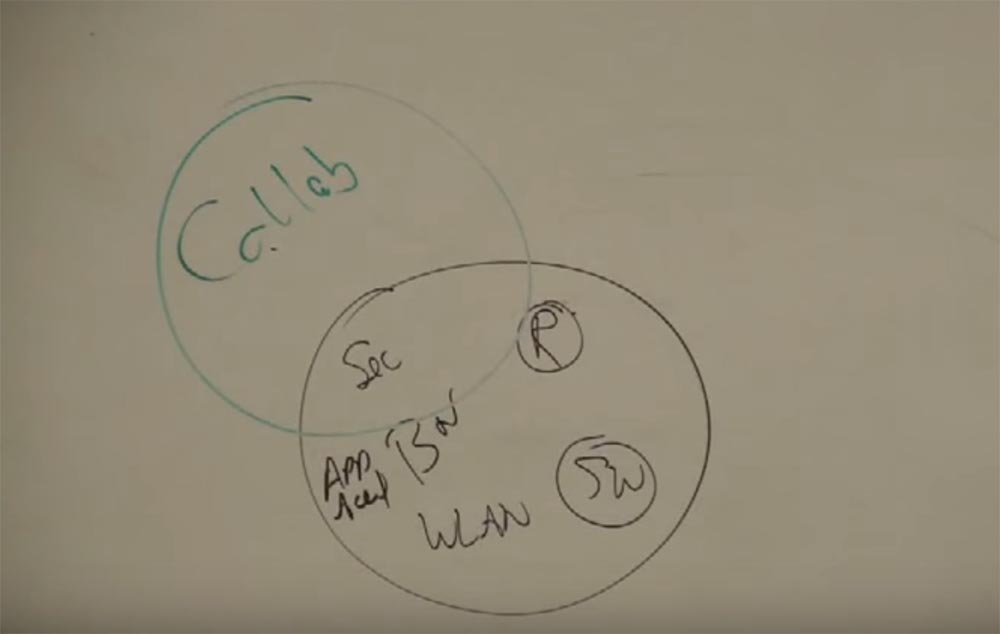
Recall again the idea of BYOD. You do not want to just bring your devices with you to surf the Internet. You need to communicate with experts, you need social functions and network capabilities. Why do we need social opportunities, do they play a role in IT or in business?
If you ask the manager about it, he will say that now the client can share his opinion on the network, and it will spread with the speed of a forest fire. But that is not all. My daughter Emily will not want to sit in class and learn in this way. She wants to meet people, communicate in a group. She will use the Facebook interface to access the information. This is the social aspect of architecture. A lot of people of my age and older will soon leave this industry, along with the knowledge that we have. How will Emily get them? Who will get them? This is a very innovative approach that leaders of all levels are now thinking about. We need to think about how modern young people want information, in what form Emily prefers to receive information.

Does it worry IT professionals? No, do not care. This should bother sellers! And you are obliged to take into account the social aspect of using networks, because it is important for the client. Those who are at the top of the pyramid, who want their business to exist for many more years, constantly think about it.
The last, third type of architecture is data center virtualization.
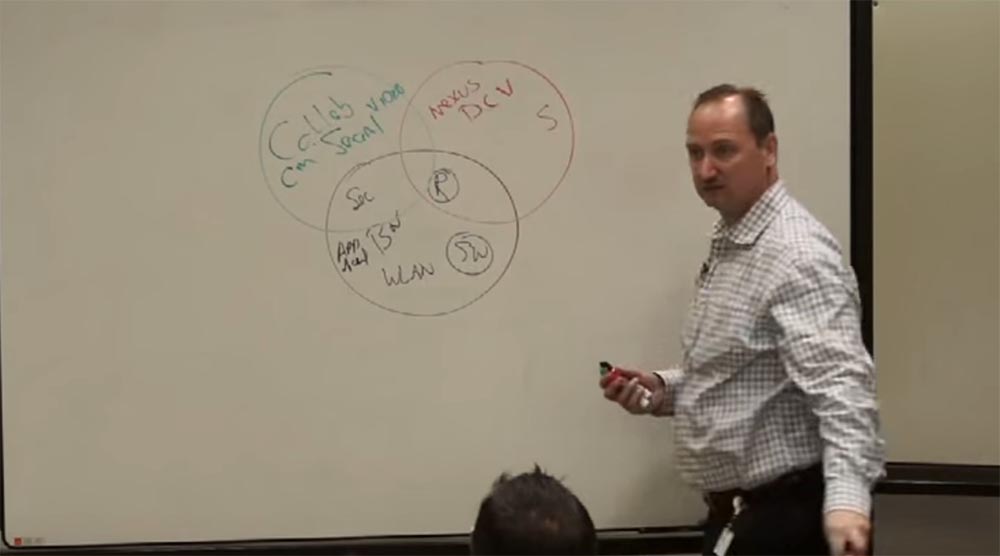
Our company Cisco is now selling Nexus servers and switches. We give customers the ability to take 16 data centers and make them look like one. We have spent a lot of time on this in the past few years. Because in the last 15 years we have been foolish and now we correct our mistakes. We finally found technology working for data centers. It was a virtual server with all these multi-core processors. Cisco has invested a lot of effort and money in this. But we'll talk more about that later. But I will again notice and ask you a question. Does the average user, the system administrator, someone who is engaged in data entry, or our clients, know whether they are working on a virtual server or not? No, most of them do not know. All this on itself drags and executes group architecture.
Initially, the alignment of forces was 6 to 1. When we started selling IP telephony, for every dollar from the phones and servers sold there were $ 6 for the switches and routers sold. Why? Because they essentially needed the infrastructure to make it work. For customers, the most important thing is quick access to information, and we have done for this more than others in a very short time. Cisco started with a 0% share of IP telephony and in 7 years reached a 35% share.
Later we will talk more about how much investment has been made in this type of architecture, why everything has paid off, and discuss the whole process from a Cisco perspective.
All these 3 architectures intersect. Who else could have done this? Let's think about the video. Let's think about the importance of the video from the point of view of the client. What does the video do with the network?
When management told IT professionals to tackle video issues, they grabbed their heads. It takes tremendous effort to do this work. You need a lot of bridges and infrastructure solutions for this purpose. Now we have started using video and recording it, so we wanted to have quick access to the servers so that we could easily upload our entire business model to the servers. And for this we need to servers worked constantly.
We need mobility. What would you do with all these Aipadas, iPhones and Android devices? After all, you want to communicate with them, right? You will want to virtualize one of these, since you know that you cannot run the Windows desktop on the iPad. But if we use Citrix or VMware, then we can run all our applications. Now we are talking about VXI, which will combine all three architectures. Is this an advantage for Cisco? Of course, without a doubt. Who else can do this? No one, only one company in the world - Cisco.
For service providers, we have a separate service provider architecture, with video, applications, mobility, wireless network capabilities, and building an IP core (intellectual property core). We can make money from it.
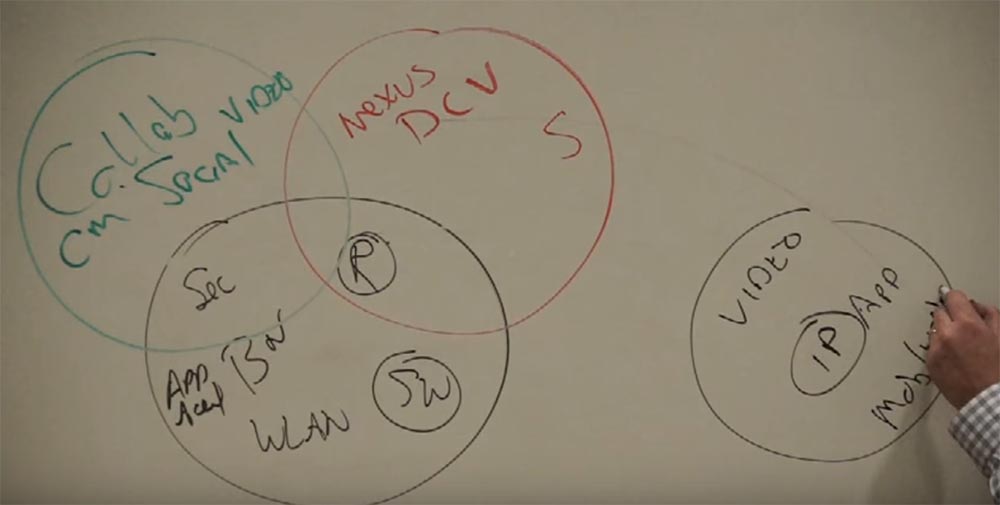
With AT & T was a funny case. I somehow consulted them in Cisco. One of AT & T's accounting executives turned to me at that time, and said that they had a problem. In fact, they had 6033 problems. What does it mean? He said that he constantly had to expand the boundaries of his network because of all these wireless technologies, to add more and more devices to increase mobility. Because of smartphones, network resource consumption has increased by 60 percent, and it needs to expand network access by 60% annually. He has to grow the IP core, although he never thought he would have to do this. He already needed to increase resources by 30%, because everyone wanted to use all these devices.
I get only 3% of the income from the project cost, imagine. And this is really very hard, a very complex type of business.
These strategies allow them to possibly take advantage of certain advantages over others. Use your own network. And if we can reduce the need for expansion to 50, 25, or 4%, then we will immediately become better than AT & T or anyone. This is what our architecture is designed to perform.
We have another architecture for the commercial sector, for medium and small businesses. We need a quick implementation to simplify the work of customers. They should not think: "I am a small client, I will not have such opportunities." Small customers want the same as large ones. They do not have such resources as large clients, but we have a whole strategy built on SMB, the network protocol of the application layer for remote access to files and network resources. And we focus more on that.
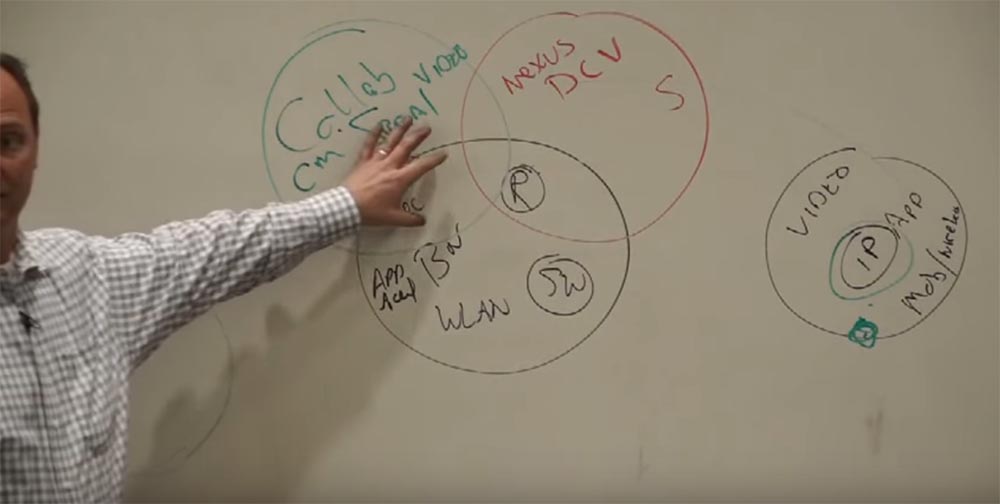
The development of architecture takes a lot of money, but managers realize that it is important for flexibility, for business, since waves of customer needs are rolling more and more often. Does it worry IT? No, they do not care. Since for them Cisco is simply an expensive company, this is what they think about Cisco. Maybe they like it and they would like them to have a CCI (commodity capital index), like the others. But these people want to continue to invest in their studies, then to get their pay for it. But architecture really matters for business leaders, for business agility. As these waves, these changes, happen faster and faster.
I have been in this business for almost 30 years and can compare what it was when we started with what we have now. Sometimes I myself do not understand if I can keep up with all the changes in the modern world. That is why people are increasingly talking about cloud technologies. Here we have cloud technologies in the right architecture.

We help people with cloud technologies. The same data center strategy that works here actually works for them. Thus, they can post and receive data. And our HCS solution, in fact, every component that we will talk about in a group architecture is the same component as in a server architecture. The difference is that the server has better management tools. Our architecture is unique. We have more ports than products at Walmart. The next time you go to Walmart, imagine the scale of Cisco. We have a SKU for all things (product item ID, article). For each product, we have at least 40 SKU, and this is important for customers. But we'll talk more about this in more detail.
Many say that Microsoft is the enemy of Cisco. And there is. We are enemies in different ways. Microsoft dominates the desktop, and when the desktop changes, computer sales fall. They will be forced to pay more attention to the video and voice in order to protect their goods, and we will try to maintain our position in this matter, since our business is keeping to this. We exist at the expense of smart networks. Microsoft says: “Hey, we need Juniper switches, HP's routers, and that’s what, accept our offer!”. Network technologies and routers are not important for them, they write their own software.
I believe that Microsoft considers our social platform a great threat to itself. They understand that people will use their products as a portal providing access to the network on other devices, but they will not be the service provider. It will be interesting to see how we will interact with them in the future.
Continued:
FastTrack Training. "Network Basics". "Basics of switching or switches." Part one. Eddie Martin December 2012
Thank you for staying with us. Do you like our articles? Want to see more interesting materials? Support us by placing an order or recommending to friends, 30% discount for Habr users on a unique analogue of the entry-level servers that we invented for you: The Truth About VPS (KVM) E5-2650 v4 (6 Cores) 10GB DDR4 240GB SSD 1Gbps $ 20 or how to share the server? (Options are available with RAID1 and RAID10, up to 24 cores and up to 40GB DDR4).
Dell R730xd 2 times cheaper? Only we have 2 x Intel Dodeca-Core Xeon E5-2650v4 128GB DDR4 6x480GB SSD 1Gbps 100 TV from $ 249 in the Netherlands and the USA! Read about How to build an infrastructure building. class c using servers Dell R730xd E5-2650 v4 worth 9000 euros for a penny?

We continue the cycle of 27 articles based on his lectures:
')
01/02: “Understanding the OSI Model” Part 1 / Part 2
03: "Understanding the Cisco Architecture"
04/05: “The Basics of Switching or Switches” Part 1 / Part 2
06: "Switches from Cisco"
07: "Area of use of network switches, the value of Cisco switches"
08/09: "Basics of a Wireless LAN" Part 1 / Part 2
10: "Products in the field of wireless LAN"
11: The Value of Cisco Wireless LANs
12: Routing Basics
13: "The structure of routers, routing platforms from Cisco"
14: The Value of Cisco Routers
15/16: “The Basics of Data Centers” Part 1 / Part 2
17: "Equipment for data centers"
18: "The Value of Cisco in Data Centers"
19/20/21: "The Basics of Telephony" Part 1 / Part 2 / Part 3
22: "Cisco Collaboration Software"
23: The Value of Collaboration Products from Cisco
24: "The Basics of Security"
25: "Cisco Security Software"
26: "The Value of Cisco Security Products"
27: "Understanding Cisco Architectural Games (Review)"
And here is the third one.
FastTrack Training. "Network Basics". Understanding Cisco Architecture. Eddie Martin December 2012
We turn to the next section of our conversation - the architecture of Cisco. We will touch this question twice, at the beginning of our meetings and at the very end.
So what is architecture for and what does it mean for the client?
Architecture is a very important concept for Cisco. In which case the architecture becomes important to the client? It is important if it is effective. If it helps to interact with applications. But what do customers think when they hear the word architecture? They imagine a strategy or something like a roadmap. For them, the word architecture sounds expensive. We all heard about ABC clients. And what clients do we call ABC clients, or “first graders,” those who have not advanced further learning the alphabet? These are the clients that did not choose Cisco. And we have to lure them.
I am from North Carolina and we have a lot of basketball teams in our state, concentrated in a small region. I loved to joke that ABC is Anything But North Carolina, anyone, but not North Carolina. Because the University of North Carolina has the best basketball team, and Kentucky has the best, and so on. It also happens in the field of information technology - there is a significant layer of “entry level” clients who are not interested in complex issues.
Architecture becomes important if we are talking about long-term strategies. Do you think the IT industry is thinking about long-term prospects? Now I will show you something very clever that one sales person taught me. He said that every organization has a hierarchy. Downstairs are performers, including IT specialists, and I, too, was among them. These people do not look far into the future. They think: "God, it's Friday, it's almost a weekend!" Or: “It's Thursday, I jumped over the middle of the week”! They do not think about distant prospects. They work from project to project and live only today.
Then we move to the level of management, managers look a little further beyond the project and think about how its consequences will affect the company in a couple of months or six months. But they are not very strategically minded; it is important for them to control the timing, timely execution of projects. However, for the former, and for the latter, the architecture of the company does not matter much.
Above the managers are directors and other managers. These people have been looking at least a year in advance. They are more strategic and the architecture for them already has some meaning. In some firms, project architects are hired for special positions, and they should keep an eye on long-term prospects and consequences, since the majority do not care.

It is at this level that a specialist is located who performs the role of an architect in an organization and knows the names of managers and so on.
The highest level - VP, SVP, CXO, we consist of general managers, their heads and directors with extensive experience of interaction, that is, CXO. CXOs are people who are associated with the name of a company, they form a brand. And these people are looking at long-term prospects.

What do all these people think at the top? What words will we describe them? What do they want?
They all want money. Therefore, they care about everything that happens. If you have ideas, it’s better to go to the top level with them. If I say that I have a plan to improve the work of the sales department and they will believe me, such a person will even get a loan if he understands that the idea has a perspective. He will create a budget for you, these are great guys, really. He will think about improving the architecture, as he looks for several years ahead.
And now back to the base of the pyramid. All these people below do not think about the company's strategy or its architecture - they just work and sell the company's products. But they do it best of all, and it is thanks to their efforts that the upper parts of the pyramid exist.
So, if you do not have an architect, the whole structure is just a set of components. The architect binds her. At the lower level, people only think about mobility, about video, they use the words “switch” and “router”. But the people at the top of the pyramid do not care, they do very different things. These levels are unrelated. The architect must place all parts of the structure where it is needed, so that everything works as efficiently as possible.
Now let's talk about the architecture of information technology, the three main types of architecture, although Cisco has a couple of others. Let's start with the first type - unlimited network architecture. What it is? A limitless network is something new. This is a completely revolutionary solution for the IT-sphere.

Saying that this type scares IT specialists to death, I am not joking. What is included in the concept of unlimited architecture? Our routers, our switches, our wireless connection, our security tools, application acceleration and much more. This is the foundation required to build a building.

Once again I draw your attention to the fact that our basic products are the basis of this architecture, which is why we exist in the market. For the sake of sales, we launched IP telephony. Why did we start selling IP telephony? To sell more routers and switches. Because clients used hubs and they had routers. And they bought from us switches and routers, about which they thought they would use them for a long time and would not replace them in the next seven years.
The second type of architecture is the collaboration architecture, group architecture. Cisco started this in the distant 1997s. Then we did not call it group architecture, there was only an idea. It originates from IP telephony, which has led to unified cooperation in the field of communications. There were a total of three steps towards such cooperation. Again, we started this in the middle of the 1990s in the form of a vision, there were no ready-made products that could provide this. We had a lot of acquisitions back then, including Celsius, a lot of routing options, and this connected us with communication messengers, video solutions, everything that provides people with the ability to communicate with each other. Of all the types of architecture, I think this is the most important, as it gives us communication. I can be a little biased, and I will. Do your customers know which switches or routers you use in architecture and what changes are there? No, and this is a common joke. But we can change the way we communicate and thus change the way everyone does business in the organization.

Recall again the idea of BYOD. You do not want to just bring your devices with you to surf the Internet. You need to communicate with experts, you need social functions and network capabilities. Why do we need social opportunities, do they play a role in IT or in business?
If you ask the manager about it, he will say that now the client can share his opinion on the network, and it will spread with the speed of a forest fire. But that is not all. My daughter Emily will not want to sit in class and learn in this way. She wants to meet people, communicate in a group. She will use the Facebook interface to access the information. This is the social aspect of architecture. A lot of people of my age and older will soon leave this industry, along with the knowledge that we have. How will Emily get them? Who will get them? This is a very innovative approach that leaders of all levels are now thinking about. We need to think about how modern young people want information, in what form Emily prefers to receive information.

Does it worry IT professionals? No, do not care. This should bother sellers! And you are obliged to take into account the social aspect of using networks, because it is important for the client. Those who are at the top of the pyramid, who want their business to exist for many more years, constantly think about it.
The last, third type of architecture is data center virtualization.

Our company Cisco is now selling Nexus servers and switches. We give customers the ability to take 16 data centers and make them look like one. We have spent a lot of time on this in the past few years. Because in the last 15 years we have been foolish and now we correct our mistakes. We finally found technology working for data centers. It was a virtual server with all these multi-core processors. Cisco has invested a lot of effort and money in this. But we'll talk more about that later. But I will again notice and ask you a question. Does the average user, the system administrator, someone who is engaged in data entry, or our clients, know whether they are working on a virtual server or not? No, most of them do not know. All this on itself drags and executes group architecture.
Initially, the alignment of forces was 6 to 1. When we started selling IP telephony, for every dollar from the phones and servers sold there were $ 6 for the switches and routers sold. Why? Because they essentially needed the infrastructure to make it work. For customers, the most important thing is quick access to information, and we have done for this more than others in a very short time. Cisco started with a 0% share of IP telephony and in 7 years reached a 35% share.
Later we will talk more about how much investment has been made in this type of architecture, why everything has paid off, and discuss the whole process from a Cisco perspective.
All these 3 architectures intersect. Who else could have done this? Let's think about the video. Let's think about the importance of the video from the point of view of the client. What does the video do with the network?
When management told IT professionals to tackle video issues, they grabbed their heads. It takes tremendous effort to do this work. You need a lot of bridges and infrastructure solutions for this purpose. Now we have started using video and recording it, so we wanted to have quick access to the servers so that we could easily upload our entire business model to the servers. And for this we need to servers worked constantly.
We need mobility. What would you do with all these Aipadas, iPhones and Android devices? After all, you want to communicate with them, right? You will want to virtualize one of these, since you know that you cannot run the Windows desktop on the iPad. But if we use Citrix or VMware, then we can run all our applications. Now we are talking about VXI, which will combine all three architectures. Is this an advantage for Cisco? Of course, without a doubt. Who else can do this? No one, only one company in the world - Cisco.
For service providers, we have a separate service provider architecture, with video, applications, mobility, wireless network capabilities, and building an IP core (intellectual property core). We can make money from it.

With AT & T was a funny case. I somehow consulted them in Cisco. One of AT & T's accounting executives turned to me at that time, and said that they had a problem. In fact, they had 6033 problems. What does it mean? He said that he constantly had to expand the boundaries of his network because of all these wireless technologies, to add more and more devices to increase mobility. Because of smartphones, network resource consumption has increased by 60 percent, and it needs to expand network access by 60% annually. He has to grow the IP core, although he never thought he would have to do this. He already needed to increase resources by 30%, because everyone wanted to use all these devices.
I get only 3% of the income from the project cost, imagine. And this is really very hard, a very complex type of business.
These strategies allow them to possibly take advantage of certain advantages over others. Use your own network. And if we can reduce the need for expansion to 50, 25, or 4%, then we will immediately become better than AT & T or anyone. This is what our architecture is designed to perform.
We have another architecture for the commercial sector, for medium and small businesses. We need a quick implementation to simplify the work of customers. They should not think: "I am a small client, I will not have such opportunities." Small customers want the same as large ones. They do not have such resources as large clients, but we have a whole strategy built on SMB, the network protocol of the application layer for remote access to files and network resources. And we focus more on that.

The development of architecture takes a lot of money, but managers realize that it is important for flexibility, for business, since waves of customer needs are rolling more and more often. Does it worry IT? No, they do not care. Since for them Cisco is simply an expensive company, this is what they think about Cisco. Maybe they like it and they would like them to have a CCI (commodity capital index), like the others. But these people want to continue to invest in their studies, then to get their pay for it. But architecture really matters for business leaders, for business agility. As these waves, these changes, happen faster and faster.
I have been in this business for almost 30 years and can compare what it was when we started with what we have now. Sometimes I myself do not understand if I can keep up with all the changes in the modern world. That is why people are increasingly talking about cloud technologies. Here we have cloud technologies in the right architecture.

We help people with cloud technologies. The same data center strategy that works here actually works for them. Thus, they can post and receive data. And our HCS solution, in fact, every component that we will talk about in a group architecture is the same component as in a server architecture. The difference is that the server has better management tools. Our architecture is unique. We have more ports than products at Walmart. The next time you go to Walmart, imagine the scale of Cisco. We have a SKU for all things (product item ID, article). For each product, we have at least 40 SKU, and this is important for customers. But we'll talk more about this in more detail.
Many say that Microsoft is the enemy of Cisco. And there is. We are enemies in different ways. Microsoft dominates the desktop, and when the desktop changes, computer sales fall. They will be forced to pay more attention to the video and voice in order to protect their goods, and we will try to maintain our position in this matter, since our business is keeping to this. We exist at the expense of smart networks. Microsoft says: “Hey, we need Juniper switches, HP's routers, and that’s what, accept our offer!”. Network technologies and routers are not important for them, they write their own software.
I believe that Microsoft considers our social platform a great threat to itself. They understand that people will use their products as a portal providing access to the network on other devices, but they will not be the service provider. It will be interesting to see how we will interact with them in the future.
Continued:
FastTrack Training. "Network Basics". "Basics of switching or switches." Part one. Eddie Martin December 2012
Thank you for staying with us. Do you like our articles? Want to see more interesting materials? Support us by placing an order or recommending to friends, 30% discount for Habr users on a unique analogue of the entry-level servers that we invented for you: The Truth About VPS (KVM) E5-2650 v4 (6 Cores) 10GB DDR4 240GB SSD 1Gbps $ 20 or how to share the server? (Options are available with RAID1 and RAID10, up to 24 cores and up to 40GB DDR4).
Dell R730xd 2 times cheaper? Only we have 2 x Intel Dodeca-Core Xeon E5-2650v4 128GB DDR4 6x480GB SSD 1Gbps 100 TV from $ 249 in the Netherlands and the USA! Read about How to build an infrastructure building. class c using servers Dell R730xd E5-2650 v4 worth 9000 euros for a penny?
Source: https://habr.com/ru/post/349344/
All Articles